In medieval times life in most villages was influenced, organised and largely controlled by two bodies. One was the Lord of the Manor, who dealt with non-ecclesiastical matters related to land and labour via manorial courts and the other body was the church. In those feudal times, the church played a dominant role in most people’s lives. For many centuries the church was, in reality, the only organisation (apart from voluntary institutions) that presided over community needs, both secular and religious. The functions were paid for by tithes paid by local land owners and organised by a church committee chaired by the Vicar. Members of the committee were, in reality, co-opted and as the landowners had a financial interest as well as local influence it is not surprising that they normally became committee members. The meetings took place in the church vestry and as a result, became widely known as Vestry Committees or Parish Vestries.
A series of subsequent laws made Vestries responsible for extra functions like the care of the poor of the parish and the upkeep of roads. However, during the 19th century, Vestry functions were gradually eroded and finally the 1894 Local Government Act made provision for elected Parish Councils for villages that had a population in excess of 300. Vestry meetings became a thing of the past and the new Parish Councils were given additional powers some of which were(1):
- The appointment of overseers of the poor.
- Maintaining and repairing closed churchyards.
- Holding or maintaining Parish property like village greens, allotments and recreation grounds.
- Acquisition of buildings for Parish purposes.
- Acquisition of land for allotments, public walks and recreation grounds.
- The Act(1) also gave the entitlement of women who owned property to vote in local elections, become poor law guardians and act on school boards.
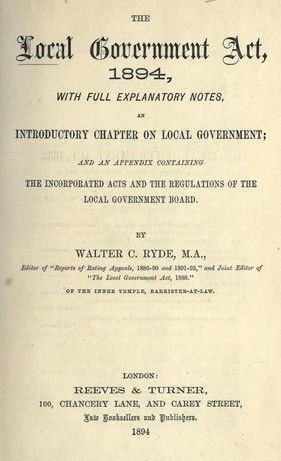
The 1894 Act(A1) gave Parish Councils the power to raise funds by precept on the Overseers’ income that was derived from money raised by a levy on agricultural land so income for Parish Councils was very limited. Consequently, we can see from the minutes of meetings that in order to pay for major projects Martham Councillors normally made a good case to Public Meetings and then asked for donations to pay for the project. What we would now call donations were called subscriptions.
Martham Parish Council became the guardian of several charities i.e. the Educational Charity, the Fuel Charity and the Poor Land Charity that owned 74 acres of land at Cess that were listed in the 1812 Inclosure Award as plot numbers 418A, 555, 567 & 573 as shown on the map below. The land was let to help raise money that was then used to support the poor and destitute – see Overseers below. Plot 573 included Common Farm which is mentioned frequently in the minutes regarding repairs and letting to a tenant farmer. Plot 418a was a small piece of land that is said to have had the Town House on it which was used to house the poor before the workhouse was built at Rollesby.
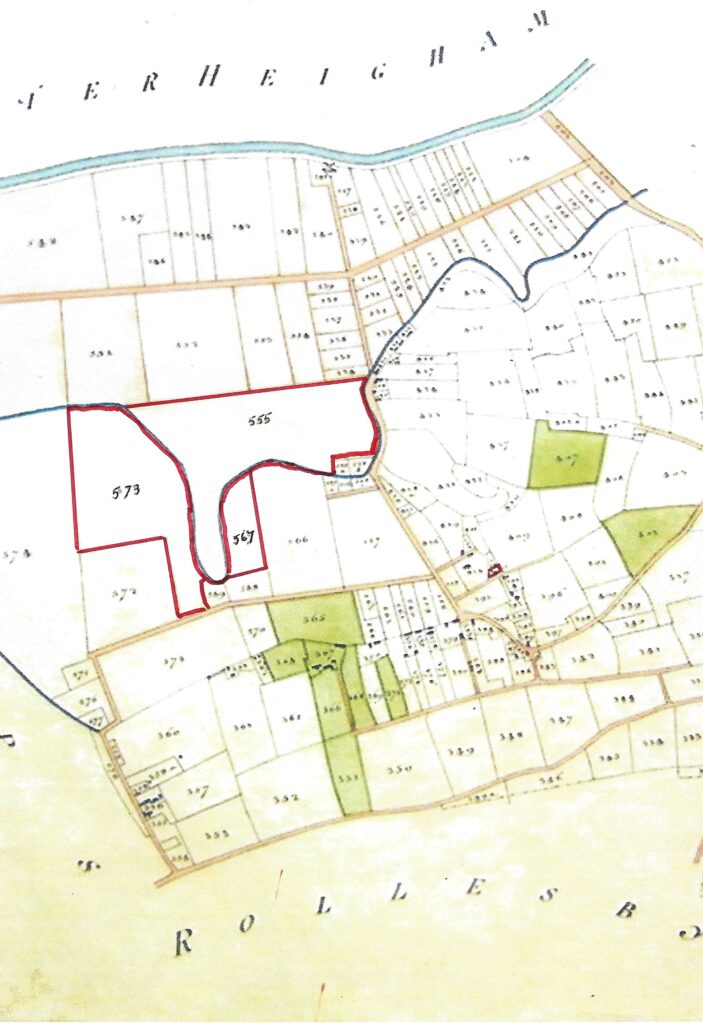
Martham’s First Election
The number of seats for each new Parish Council was based on its population. There was a great deal of competition for a seat on the new Martham Parish Council in 1894 and 24 people contested the eleven available seats.

At first, elections took place annually and new Councillors had to be elected at a Public Meeting in time for their annual year of service to begin on 15th April. The first Martham election took place at the Board School on 4th & 17th December 1894 and the results were published in the Norwich News on 22nd December 1894 as shown below. The winning 11 Councillors attracted a total of 1,080 votes between them against a total population of 1,177. Taking into account that the 13 people who missed out on getting a seat but also attracted support the overall percentage turnout was probably over 95% of the population which is an enormous number and indicates the popularity of the new arrangements.

The First Eleven Councillors were:-
BLYTH, George William (1847-1929). Born at Caister-on-Sea, George married Louisa Green who was a Martham girl and they lived all their lives in Repps Road. He was a bricklayer and builder at the time of his election but later became a market gardener and cow keeper.
BRACEY, William James (1847-1922). Originally from Great Yarmouth, William was a very successful self-employed builder and brickmaker. He had relocated to Cess Road, Martham in the early 1890’s. It is quite possible that William was the builder of Bracey’s Terrace, Cess Road, where he lived. In 1896 his son, William Jnr. was also elected to the Council.
FUTTER, Henry (1861-1938). Born into a lowly background, by 1894 Henry had become a respected carpenter, joiner and builder. He married Arletta Skoyles in 1880 and they lived in the village for the whole of their lives.
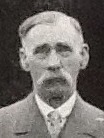
GRIMBLE, George (1846-1922): Born in Martham in 1846 George was a small-time farmer who lived for many years at what is today Brickfield Farm in Staithe Road. He was the father of William who was also a Councillor.
GRIMBLE, William Frederick (1875-1940). William was born at Brickfield Farm, Staithe Road. He was the youngest of the first Parish Councillors. His parents were George & Emily and George ran the farm. William moved to Great Yarmouth before 1901.
JEARY, Herbert Wilson Snr (1866-1931). Born in 1866, Herbert represented the fourth generation of butchers in his family. They had a long-established business in White Street. In a long career he was also a Justice of the Peace, District Councillor and County Councillor.
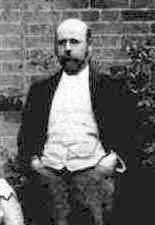
JOHNSON, Frederick Groom (1870-1927). Frederick was born in 1870 at Ormesby St Michael. By 1894 he was living with his widowed mother at Elmside House, White Street in Martham helping out with their large farm. In 1895 he married Eleanor, nee Playford who was from Potter Heigham.
LOVE, John (1850-1903). He was the Lord of the Manor in 1894 and lived at The Hall, Hall Road. As such he was the largest landowner in the village at the time. He was originally from Crostwight, Norfolk where his family owned a substantial amount of land.
PYMAN, James Rix (1860-1899). Born at Scanning, James purchased a very successful grocer and draper business situated in White Street that had been run for many years by the Linford family. James took over the store in about 1884/85 and called it Pyman’s Store. There are a number of lovely photographs of it that you can see by clicking HERE.
ULPH, William Gladstone (1868-1940). During 1894 William lived at Grange Farm, Cess Road where he was a gentleman farmer of about 270 acres but he was not a local, having been born in Middlesex and died in London.
WARNES, William Grimson (1843-1929). William was born in Martham in 1843. At the time of the election in 1894 he lived at Damgate and was a market gardener and farmer of about 20 acres. He was related to the very large Warnes and Watson families of Martham so perhaps he was able to draw on their support to help make him a winner in the election.
A list of all the Councillors who held office during the first five years of the Council can be seen at Appendix A1, which also gives their occupations.
Meetings
The first meeting of Martham Parish Council was held on 2nd January 1895 when the new Councillors declared their Acceptance of Office. Meetings during this period were held at the former First School in School Road, which at the time was called the Board School because it was run by an elected Board as required under the Elementary Education Act 1870. The meetings were probably held there because the 1894 Act(1) required schools to provide a venue free of charge.
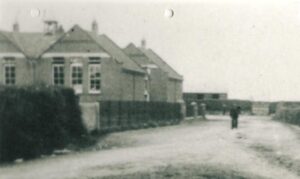
The regulations under which Parish Councils operated were not very tight in the beginning and the influence of the Church was not easily diminished. In fact, in the early days, the Chairman would usually be the vicar and would at times be co-opted on to the Parish Council if he had not been elected. This is what happened at Martham and the Rev. George Merriman chaired most of the meetings from 1894 until he died in 1905 but he did not have a vote. Statutory Parish Council meetings were held quarterly but there was so much business to be dealt with that meetings were held more or less monthly and some overran so that adjournment meetings had to be held a few days later to complete business. The Council played an important part in the community and in order to manage its many responsibilities appointed a number of sub-committees that looked after various matters like Charities, Allotments, Footpaths and Common Farm etc They also appointed working parties for one-off topics like pond cleaning, lighting and management of marshes and dykes. The sub-committees and working parties then reported to the Council meetings. In some ways this was a continuation of Vestry meetings and a small number of influential members retained control of what was going on. Over time, the sub-committees reduced in number and if anything more public meetings were held in order to gauge community wishes and gather volunteers. In addition to the Parish Council meetings, an open Public Meeting had to be held once a year at which Councillors were elected for one year, with the old Council retiring and the new Council coming into office on 15th April. This applied from 1894 until 1900 when the law changed(S2) and those elected from 1901 onwards enjoyed a term of three years. (Much later, in 1972(S3), the term of office became four years). Members of the public often used Annual Public Meetings to ask questions and suggest village improvements.
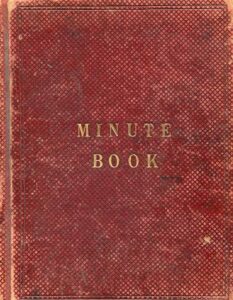
The recording of the minutes from 1894 to 1899 was carried out using three minute books. One book was used to record the main MPC meetings. A second book was used to record MPC Committee and occasional meetings and a third book was used to record Parish Meetings including both annual and special meetings. All three books had preprinted page numbers but they all started from No1 so sometimes things can get a bit confusing.
There is no record of any Councillor giving up or moving away part way through his term of office. No ladies were elected to become a Councillor during the first five years of the Council even though the 1894 Act(A1) expressly allowed ladies to stand for election. In fact, the village had to wait about another 50 years before a lady was elected to become a Parish Councillor and she was Mrs Kate Adelle Francis the local shopkeeper and businesswoman who was elected on 21st June 1949. There is a list of the minutes of meetings for the first five years of the Council in Appendix A2 but here is a copy of the minutes of the first Parish Council meeting held on 2nd January 1895.
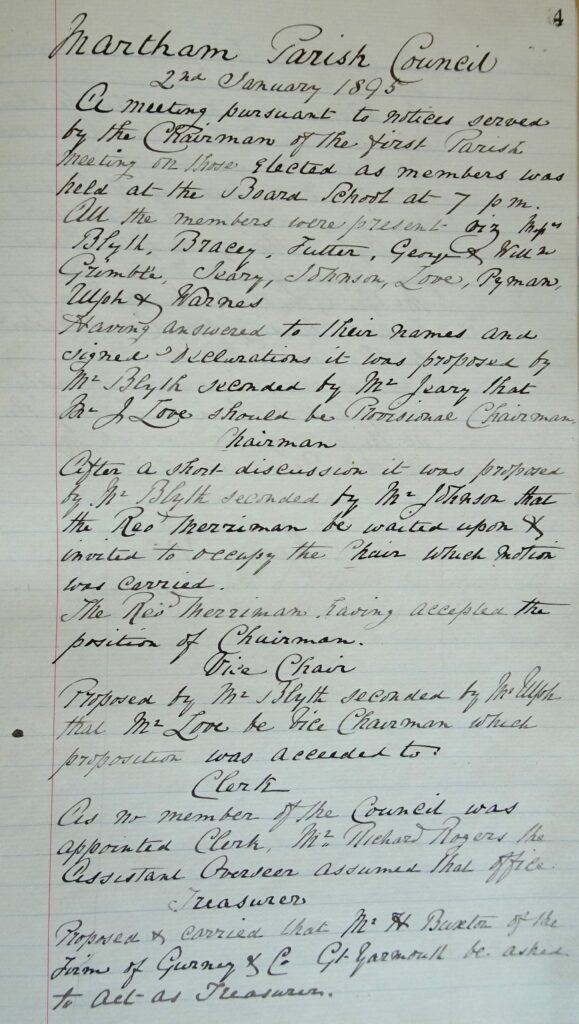
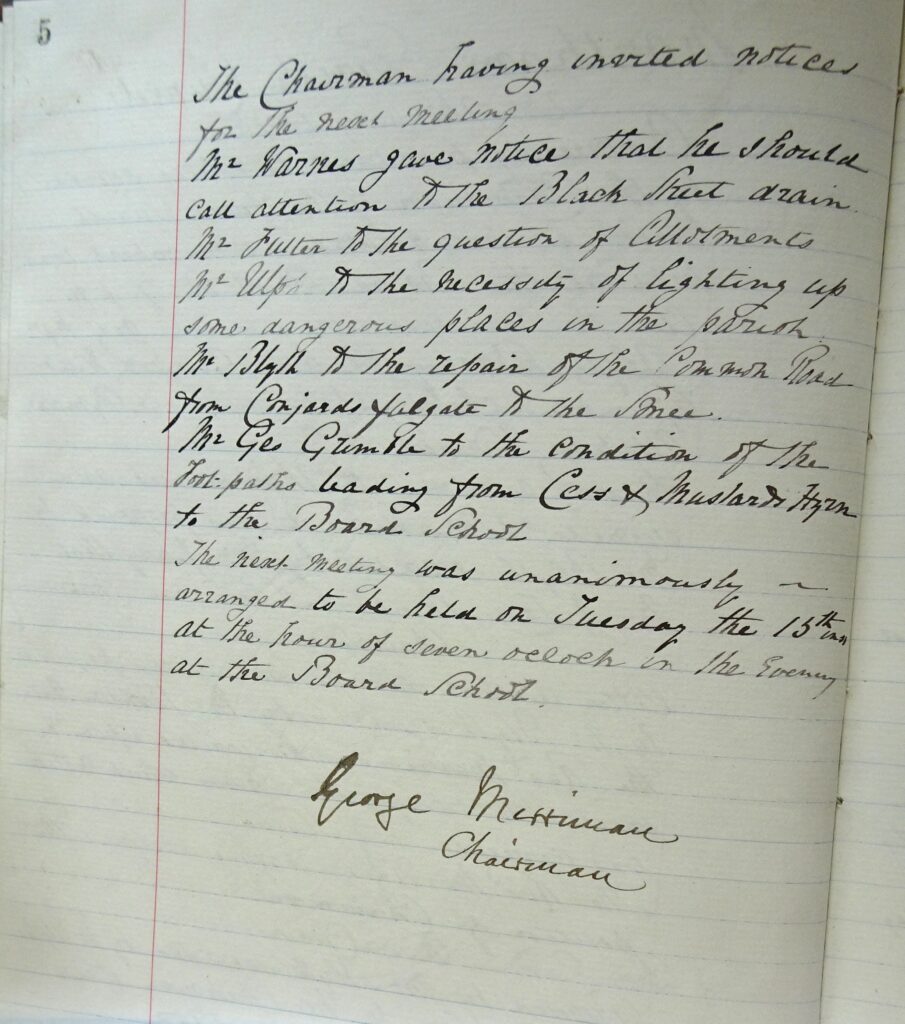
Key Parish Council Events 1894 to 1899.
- Throughout this period the Parish Council administered the Poor Lands Charity, the Fuel Charity and the General Education Charity. The Overseers would have played an active role in this and regular reports of the accounts were made to the Annual Parish Meetings. In addition, the Council ran allotments and owned a farm off Common Road that it ran in conjunction with the marshes it owned at Cess.
- The first meeting of MPC was held on 2nd January 1895 and in order to bring meetings together for subsequent financial years the first annual Parish Meeting was held on 25th March 1895.
- The Parish Council played an active part in organising the village celebrations for the Diamond Jubilee of Queen Victoria to take place on 22nd June 1897 to mark the Queen’s 60th Anniversary of Accession to the Throne. Several public meetings were held to consult on ideas for the celebration. The three most popular ideas were: a tea for everyone in he village; sports events; or the provision of street lighting. A list was created for people to say which of the three they would be willing to pay towards. Fundraising must have gone well because 216 pints of ginger beer were ordered to help support the tea & sport events.
- In 1899 the Council organised a major repair of Common Road, Cess and collected donations to pay the cost.
An Overseer.
In 1894 the new Parish Councils became responsible for a wide range of functions, including the administration of the Poor Laws, which were crucial for the support of the poor and infirm. Overseers were responsible for the collection of the Poor Rate, which was a property tax based on the value of real estate. They ensured the Poor Laws were properly administered, including the provision of relief to those in need. They took action if Poor Rates were not paid and could impose fines in cases of failure to pay. They represented the Council to ensure it met its responsibilities for the proper operation of workhouses and managing the care of the inmates which in the case of Martham was a joint operation with the workhouse at Rollesby.
Sources:
S1. 1894 Local Government Act c.73 ss.5-10.
S2. The Parish Councillors (Tenure of Office) Act 1899.
S3. 1972 Local Government Act.
Appendix A – List of Councillors from 1894 to 1899
| Martham Parish Councillors 1894 to 1899 | ||||||
|---|---|---|---|---|---|---|
| Period as a Councillor | ||||||
| Occupation | From | To | ||||
| BLYTH, George William | Builder | 17.12.1894 | 14.4.1897 | |||
| BRACEY, William (b1870 Jnr.) | Farmer & builder | 15.4.1896 | 14.4.1901 | |||
| BRACEY, William James (b1847 Snr.) | Builder | 17.12.1894 | 14.4.1899 | |||
| BROWN, James | Farmer | 15.4.1899 | 14.4.1901 | |||
| DYBALL, George Humphrey | Farmer & Corn and Flour Merchant | 15.4.1899 | 14.4.1913 | |||
| DYBALL, Thomas (b1831) | Farmer & Corn and Flour Merchant | 15.4.1897 | 14.4.1899 | |||
| EDWARDS, Alfred Robert (b1853) | Tailor | 15.4.1897 | 14.4.1899 | |||
| FUTTER, Henry (1st term) | Carpenter/builder | 17.12.1894 | 14.4.1899 | |||
| FUTTER, Henry (2nd term) | Carpenter/builder | 11.7.1899 | 23.5.1904 | |||
| GRIMBLE, Frederick William | Farmer's son | 17.12.1894 | 14.4.1896 | |||
| GRIMBLE, George (1st term) | Farmer | 17.12.1894 | 14.4.1897 | |||
| GRIMBLE, George (2nd term) | Farmer | 15.4.1898 | 23.5.1904 | |||
| HULME, William Rowland | Schoolmaster | 15.4.1897 | 14.4.1899 | |||
| JEARY, Herbert Wilson | Butcher | 17.12.1894 | Aft 1921 | |||
| JOHNSON, Frederick Groom | Helped father on farm | 17.12.1894 | 14.4.1896 | |||
| KNIGHTS, Richard George Barber | Farmer | 15.4.1896 | 14.4.1901 | |||
| LOVE, John (b1850 Snr.) | Landowner/farmer | 17.12.1894 | 14.4.1897 | |||
| LOVE, John (b1875 Jnr.) | Landowner/farmer | 15.4.1896 | 14.4.1897 | |||
| PYMAN, James Rix | Shop owner/keeper | 17.12.1894 | 23.5.1899* | |||
| RIGG, William Arthur | Baker | 15.4.1898 | 14.4.1899 | |||
| RUST, Daniel (b1854) | Millwright & coal dealer | 15.4.1896 | 14.4.1901 | |||
| STARLING, Oliver Aldred | Agricultural engineer | 15.4.1897 | c1905? | |||
| ULPH, William Gladstone | Farmer | 17.12.1894 | 14.4.1896 | |||
| WARNES, William Grimson | Market gardener | 17.12.1894 | 14.4.1900 | |||
| WILKINSON, Henry Etridge | Vet | 15.4.1899 | 14.4.1907 | |||
| WISEMAN, Alfred Mabbott | Farmer | 15.4.1897 | 14.4.1899 | |||
| * James PYMAN died 23.5.1899 and was replaced by Henry FUTTER. |
Appendix A2 – Minutes List 1894-1899
Below is a list of all the Martham Parish Council (MPC) main meetings and the key annual Public Meetings (PM) for the period 4th December 1894 to 31st December 1899. You can read the actual minutes for these meetings by clicking on the dates below. This will open a pdf copy of the minutes for the selected meeting in a new window.
In addition to these meetings many other MPC sub-committee meetings were held and special Public Meetings to consider things like arrangements for special occasions. The minutes for these casual meetings have not been reproduced but are available on request. The early meetings of MPC were mainly taken up with process, management issues, allotment lettings, footpath maintenance and reports from charity sub-committees. Drainage matters at Black Street and White Street and how they affected ponds that they drained into took up a great deal of time. The Council owned Common Farm, Cess and marshes and many meetings feature repairs needed to the farm and management of the marshes and dykes. The new Council was detail-conscious and did not exercise much delegation so many regular matters like authorising payments were repeated on most agendas. As a result, I have only highlighted exceptional matters dealt with at each meeting. References to page numbers are the page numbers of the minute books.
- 4.12.1894 – PM. A meeting was held by the Overseers to receive nominations for new Councillors as required by the 1894 Local Government Act. Pages 1 & 2.
- 17.12.1894 – PM. A special public meeting was held for the election of the first Parish Councillors from those nominated on 4.12.1894. Page 3.
- 2.1.1895 – MPC. First meeting of MPC. The new eleven members signed their declarations of Acceptance of Office. Richard Rogers was appointed as Clerk and the minute book shows his handwritten minutes. Pages 4 & 5.
- 15.1.1895 – MPC meeting. A precept of 1d (one old pence) in the pound was agreed. Pages 6 to 9.
- 29.1.1895 – MPC meeting. Ponds, cesspits, street lighting, Common Road repairs were discussed. Pages 10 to 12.
- 12.2.1895 – MPC meeting. Pages 13 to 18. Page 17 is blank.
- 12.3.1895 – MPC meeting. Purchase of additional allotment land was considered. Pages 19 to 20.
- 25.3.1895 – PM. A public meeting was held to consider the parochial elections. Page 4.
- 26.3.1895 – MPC. William Tungate (well known as a thatcher) who had been the Constable for the past two years was confirmed as Parish Constable again for the remainder of the current year. Pages 21 & 22.
- 29.3.1895 – MPC. Tenders for drainage work at Black Street were considered. Pages 23 & 24.
- 16.4.1895 – MPC AGM. Herbert Jeary & Thomas Dyball were appointed as Oversees for the next year. The Clerk’s salary of £4 was agreed for the past year, suggesting he had worked for the first year without knowing he would be paid. The sum of £18 was budgeted for the payment of the Clerk and Overseers for the 1895/96. A precept of 2d (two old pence) in the pound was agreed for 1895/96. Pages 25 to 27.
- 7.5.1895 – MPC pages 28 to 30.
- 4.6.1895 – MPC pages 31 & 32.
- 2.7.1895 – MPC. Black Street drainage scheme contract discussed. Pages 33 to 35.
- 30.7.1895 – MPC. Poor Lands Charity transfer to Council agreed by the Charity Commission. Pages 36 & 37.
- 13.8.1895 – First part of drainage works paid for. Page 38.
- 9.9.1895 – Proposals for The Greens to be a public recreation space were discussed as a result of recent damage to the grass. Pages 39 & 40.
- 1.10.1895 – Common Farm repairs. Registration of The Greens as a recreation ground was discussed. Pages 41 & 42.
- 29.10.1895 – Pages 43 to 45.
- 26.11.1895 – Pages 46 to 48.
- 12.12.1895 – Meeting of MPC as Trustees of the Fuel Charity. Page 49 & 50.
- 14.1.1896 – MPC. The Clerk was awarded two guineas for extra work. Pages 51 to 54.
- 9.3.1896 – PM. The meeting elected the Parish Councillors for 1896/97. Pages 5 & 6.
- 24.3.1896 – PM. The meeting received reports and accounts from most of the Charities in the Village. Pages 7 & 8.
- 4.2.1896 – MPC. Pages 55 to 57.
- 3.3.1896 – MPC. Hiring of land at Pond Pightle for allotments. The Clerk was paid £5 for extra meetings over the past year. Pages 58 to 60.
- 30.3.1896 – Special MPC meeting to consider accounts. Pages 61 & 62.
- 21.4.1896 – Second annual meeting of MPC. William Tungate gave up being the Constable after three years of service and George William Blyth was appointed to replace him. Pages 63 to 67.
- 13.5.1896 – MPC. Extra land for allotments acquired. Pages 68 to 71.
- 14.7.1896 – MPC. Repairs to the stile on the footpath near the Baptist Church were agreed. Complaints about sewerage drains contaminating the pond opposite the King’s Arms were discussed. Pages 72 to 75.
- 28.7.1896 – MPC. Pages 76 to 78.
- 4.9.1896 – MPC special meeting to consider drainage and ponds. Concrete surround to King’s Arms pond and sluices suggested. Pages 79 & 80.
- 8.9.1896 – MPC. Further efforts to obtain Manorial Rights over The Green. Pages 81 to 84.
- 13.10.1896 – MPC. A sluice door had been fitted to the pond on the east of The Green. Repairs to private roads discussed. Pages 85 to 87.
- 10.11.1896 – MPC. Pages 88 to 90.
- 12.1.1897 – MPC. Pages 91 & 92.
- 26.1.1897 – MPC. Pages 93 & 94. Complaints about encroachment on The Greens. Three nominations for Constable were listed. Pages 95 & 96.
- 9.3.1897 – MPC. Pages 97 to 100.
- 18.3.1897 – PM. Parish Councillors for 1897/98 were elected and Charity accounts received. Pages 11 to 13.
- 15.4.1897 – MPC third annual meeting. Ten members signed their declaration of office for the new year. William Bracey Jnr. and Thomas Dyball were appointed as Overseers for the coming year. Pages 101 to 104.
- 27.4.1897 – MPC. A Public Meeting to consider arrangements for celebrating Queen Victoria’s Diamond Jubilee was agreed. Pages 105 to 107.
- 28.4.1897 – PM. A Public Meeting was held to consider suggestions for celebrating Queen Victoria’s Diamond Jubilee.
- 13.7.1897 – MPC pages 108 to 110.
- 3.8.1897 – MPC. Mr Rogers was still the Clerk but Mr Edwin Braddock was accepted as his assistant. Pages 111 & 112.
- 12.10.1897 – MPC. Pages 113 to 116.
- 16.11.1897 – MPC. Pages 117 & 118.
- 6.12.1897 – MPC. Pages 119 & 120.
- 8.12.1897 – MPC. Page 121.
- 13.12.1897 – MPC. Repairs to Common Road were investigated subject to the adjacent landowner’s views. Pages 122 to 124.
- 1898 – The minutes for the Annual Public Meeting have been lost but the results of the election of Councillors for 1898/99 can be seen under the MPC meeting dated 19th April 1898.
- 7.1.1898 – MPC. Complaints were made to Norfolk CC about the state of the village roads that needed repairs. Mr David Thompson was nominated as the Parish Constable for 1889/90. Pages 125 to 128.
- 19.4.1898 – Fourth Annual Meeting of MPC. Eleven members signed their Declaration of Office for the new year. Messrs Bracey & Dyball were appointed as Overseers again for 1898/99. Pages 129 to 131.
- 12.7.1898 – MPC. Ponds and drainage expenses were discussed again. Pages 132 & 133.
- 11.10.1898 – MPC. Pages 134 to 136.
- 8.11.1898 – MPC. Dyke cleaning discussed. Pages 137 & 138.
- 5.12.1898 – MPC. Pages 139 & 140.
- 10.1.1899 – MPC. Pages 141 to 142.
- 6.3.1899 – PM. Parish Councillors for 1899/1900 were elected. Pages 25 & 26.
- 8.3.1899 – MPC. Special Meeting. Pages 143 & 144.
- 17.3.1899 – Fifth Annual Meeting of MPC. Ten members signed their Declaration of Office for the new year (Cllr. Rust signed his at the next meeting). Mr David Thompson was nominated as Parish Constable for 1899/90. William Bracey Jnr. and Oliver Starling were appointed Overseers for 1899/90. Pages 145 to 148.
- 26.4.1899. MPC. A scheme for the repair of Common Road was proposed to be determined by a Committee of the Council consisting of all the Councillors. Page 149.
- 26.6.1899 – MPC. Special Meeting to consider what to do about Plot No160 of the Inclosure Award allotted to the Church Wardens & Overseers that had been put up for sale with some private property; solicitor appointed to investigate. Page 150.
- 11.7.1899 – MPC. Henry Futter became a Councillor upon the death of Councillor James Rix Pyman. The County Council were asked to provide a footway from the junction of Repps Road and Station Road (now Rollesby Road) to the Railway Station.
The Council’s solicitor reported on his investigations into the ownership of Plot No160 of the Martham Inclosure Award. He reported that Plot No160 had been sold by the Churchwardens and Overseers on 18th June 1839 to Richard Garnham of Martham for £40. It was then sold by Richard Garnham in 1870 to Robert Huggins. Following his death the sale of property belonging to Mr Huggins had been advertised for auction in June 1899. The information was noted and no further action was taken. Pages 151 to 153. - 14.9.1899 – MPC. A precept on the Overseers of 1d (one old penny) in the pound for the financial year ending 31st March 1900 was agreed. Pages 154 & 155.
- 10.10.1899 – MPC. It was noted that stone had been delivered in preparation for the repairs at Common Road. Pages 156 & 157.
- 25.10.1899 – MPC. Pages 159 to 160.
- 13.11.1899 – MPC. A special meeting was held to consider the acquisition of the Village Green. The District Council was requested to take steps to register The Greens under the Commons Act 1899. Page 161.
- 6.12.1899. MPC. Pages 162 to 164.